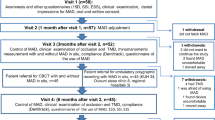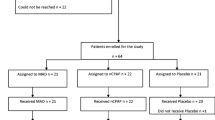Abstract
Purpose
This 10-year follow-up prospective study aimed to evaluate the effects of treatment with a mandibular protruding device (MPD) on respiratory parameters and subjective symptoms in patients with obstructive sleep apnea (OSA) or snoring.
Methods
Seventy-seven consecutive patients diagnosed with OSA or snoring were treated with an MPD. At baseline and the 10-year follow-up, a polygraphic examination and questionnaires on sleep quality were administrated and weight, and neck size was measured.
Results
At the 10-year follow-up, we examined 64 of the 77 patients and recorded their current treatment (45 MPD, 9 continuous positive airway pressure (CPAP), and 10 no treatment). For MPD patients, 89 % reported MPD use every night and 9 % several nights a week. Compared to baseline, MPD users with OSA had a significantly decreased oxygen desaturation index (ODI) (p = 0.006) and increased lowest arterial oxygen saturation, SaO2 nadir (p = 0.007) after 10 years. MPD treatment was successful for 70 % of OSA patients, yet 89 % subjectively considered themselves cured, indicating overestimation of the treatment effect. OSA patients who responded to treatment maintained baseline weight and neck size, while these increased for non-responders. Of the baseline snorers still using an MPD, 93 % maintained an ODI value of <5. All CPAP users had an ODI value of <5. Both OSA and snorers using an MPD had significantly fewer self- and relative reports of snoring, apnea, daytime tiredness, and poor night sleep quality (p < 0.001).
Conclusions
MPD treatment is well tolerated and effective in a long-term, 10-year perspective. Weight gain may jeopardize MPD effects. Both patients and relatives reported significantly less snoring and fewer periods of apnea.



Similar content being viewed by others
References
Peker Y, Hedner J, Norum J, Kraiczi H, Carlson J (2002) Increased incidence of cardiovascular disease in middle-aged men with obstructive sleep apnea: a 7-year follow-up. Am J Respir Crit Care Med 166:159–165
Yaggi HK, Concato J, Kernan WN, Lichtman JH, Brass LM, Mohsenin V (2005) Obstructive sleep apnea as a risk factor for stroke and death. N Engl J Med 353:2034–2041
Marin JM, Carrizo SJ, Vicente E, Agusti AG (2005) Long-term cardiovascular outcomes in men with obstructive sleep apnoea-hypopnoea with or without treatment with continuous positive airway pressure: an observational study. Lancet 365:1046–1053
Tregear S, Reston J, Schoelles K, Phillips B (2009) Obstructive sleep apnea and risk of motor vehicle crash: Systematic review and meta-analysis. J Clin Sleep Med 5:573–581
Lim J, Lasserson TJ, Fleetham J, Wright J (2006) Oral appliances for obstructive sleep apnoea. Cochrane Database Syst Rev:CD004435
Ferguson KA, Cartwright R, Rogers R, Schmidt-Nowara W (2006) Oral appliances for snoring and obstructive sleep apnea: a review. Sleep 29:244–262
Hoffstein V (2007) Review of oral appliances for treatment of sleep-disordered breathing. Sleep Breath 11:1–22
Gagnadoux F, Fleury B, Vielle B, Petelle B, Meslier N, N'Guyen XL, Trzepizur W, Racineux JL (2009) Titrated mandibular advancement versus positive airway pressure for sleep apnoea. Eur Respir J 34:914–920
Aarab G, Lobbezoo F, Hamburger HL, Naeije M (2011) Oral appliance therapy versus nasal continuous positive airway pressure in obstructive sleep apnea: a randomized, placebo-controlled trial. Respiration 81:411–419
Phillips CL, Grunstein RR, Darendeliler MA, Mihailidou AS, Srinivasan VK, Yee BJ, Marks GB, Cistulli PA (2013) Health outcomes of continuous positive airway pressure versus oral appliance treatment for obstructive sleep apnea: a randomized controlled trial. Am J Respir Crit Care Med 187:879–887
Fransson AM, Tegelberg A, Leissner L, Wenneberg B, Isacsson G (2003) Effects of a mandibular protruding device on the sleep of patients with obstructive sleep apnea and snoring problems: a 2-year follow-up. Sleep Breath 7:131–141
Marklund M, Franklin KA, Sahlin C, Lundgren R (1998) The effect of a mandibular advancement device on apneas and sleep in patients with obstructive sleep apnea. Chest 113:707–713
Aarab G, Lobbezoo F, Heymans MW, Hamburger HL, Naeije M (2011) Long-term follow-up of a randomized controlled trial of oral appliance therapy in obstructive sleep apnea. Respiration 82:162–168
Walker-Engstrom ML, Tegelberg A, Wilhelmsson B, Ringqvist I (2002) 4-year follow-up of treatment with dental appliance or uvulopalatopharyngoplasty in patients with obstructive sleep apnea: a randomized study. Chest 121:739–746
Ghazal A, Sorichter S, Jonas I, Rose EC (2009) A randomized prospective long-term study of two oral appliances for sleep apnoea treatment. J Sleep Res 18:321–328
Mehta A, Qian J, Petocz P, Darendeliler MA, Cistulli PA (2001) A randomized, controlled study of a mandibular advancement splint for obstructive sleep apnea. Am J Respir Crit Care Med 163:1457–1461
Randerath WJ, Heise M, Hinz R, Ruehle KH (2002) An individually adjustable oral appliance vs continuous positive airway pressure in mild-to-moderate obstructive sleep apnea syndrome. Chest 122:569–575
Schmidt-Nowara WW, Meade TE, Hays MB (1991) Treatment of snoring and obstructive sleep apnea with a dental orthosis. Chest 99:1378–1385
O’Sullivan RA, Hillman DR, Mateljan R, Pantin C, Finucane KE (1995) Mandibular advancement splint: an appliance to treat snoring and obstructive sleep apnea. Am J Respir Crit Care Med 151:194–198
Lam B, Sam K, Lam JC, Lai AY, Lam CL, Ip MS (2011) The efficacy of oral appliances in the treatment of severe obstructive sleep apnea. Sleep and Breathing 15:195–201
Fransson AM, Isacsson G, Leissner LC, Nasman AB, Alton MK (2001) Treatment of snoring and obstructive sleep apnea with a mandibular protruding device: an open-label study. Sleep Breath 5:23–33
Fransson AM, Tegelberg A, Johansson A, Wenneberg B (2004) Influence on the masticatory system in treatment of obstructive sleep apnea and snoring with a mandibular protruding device: a 2-year follow-up. Am J Orthod Dentofacial Orthop 126:687–693
Marklund M, Stenlund H, Franklin KA (2004) Mandibular advancement devices in 630 men and women with obstructive sleep apnea and snoring: Tolerability and predictors of treatment success. Chest 125:1270–1278
Kushida CA, Morgenthaler TI, Littner MR et al (2006) Practice parameters for the treatment of snoring and Obstructive Sleep Apnea with oral appliances: an update for 2005. Sleep 29:240–243
Otsuka R, Almeida FR, Lowe AA, Ryan F (2006) A comparison of responders and nonresponders to oral appliance therapy for the treatment of obstructive sleep apnea. Am J Orthod Dentofacial Orthop 129:222–229
Eggensperger N, Smolka W, Iizuka T (2005) Long-term changes of hyoid bone position and pharyngeal airway size following mandibular setback by sagittal split ramus osteotomy. J Craniomaxillofac Surg 33:111–117
Liu Y, Lowe AA, Fleetham JA, Park YC (2001) Cephalometric and physiologic predictors of the efficacy of an adjustable oral appliance for treating obstructive sleep apnea. Am J Orthod Dentofacial Orthop 120:639–647
Walker-Engstrom ML, Ringqvist I, Vestling O, Wilhelmsson B, Tegelberg A (2003) A prospective randomized study comparing two different degrees of mandibular advancement with a dental appliance in treatment of severe obstructive sleep apnea. Sleep and Breathing 7:119–130
Hoekema A, Doff MH, de Bont LG, van der Hoeven JH, Wijkstra PJ, Pasma HR, Stegenga B (2007) Predictors of obstructive sleep apnea-hypopnea treatment outcome. J Dent Res 86:1181–1186
Conflict of Interest
None
Author information
Authors and Affiliations
Corresponding author
Rights and permissions
About this article
Cite this article
Wiman Eriksson, E., Leissner, L., Isacsson, G. et al. A prospective 10-year follow-up polygraphic study of patients treated with a mandibular protruding device. Sleep Breath 19, 393–401 (2015). https://doi.org/10.1007/s11325-014-1034-5
Received:
Revised:
Accepted:
Published:
Issue Date:
DOI: https://doi.org/10.1007/s11325-014-1034-5




